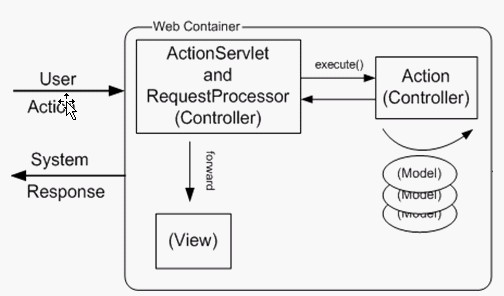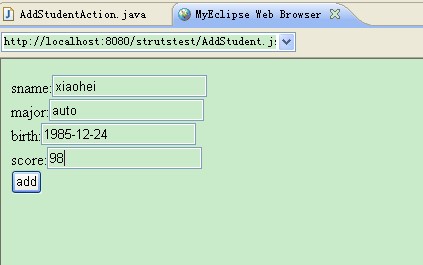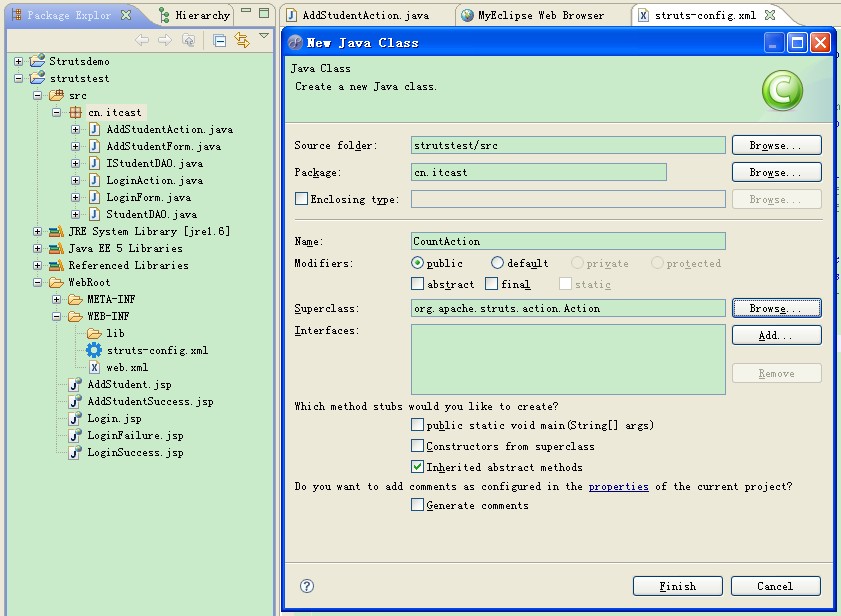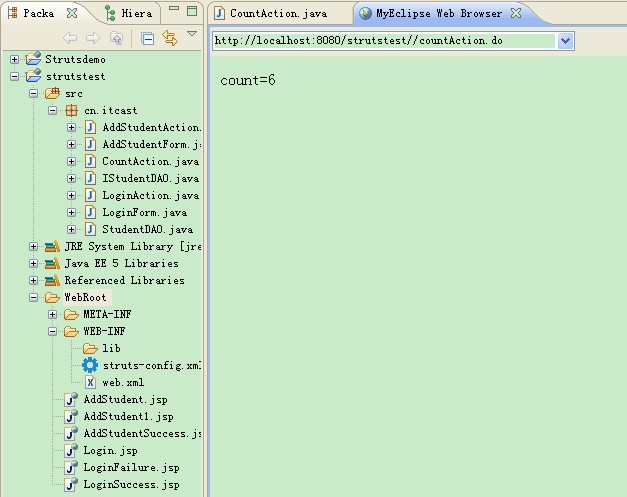Struts的MVC組件
組件包括:ActionServlet 、Action Classes 、Action Mapping(此處包括ActionForward)、ActionForm Bean。
Struts中的MVC:
1、模型(Model):本質(zhì)上來(lái)說(shuō)在Struts中Model是一個(gè)商業(yè)邏輯類,開(kāi)發(fā)者實(shí)現(xiàn)商業(yè)邏輯。
2、視圖(View):View是由與控制器Servlet配合工作的一整套JSP定制標(biāo)簽庫(kù)構(gòu)成,利用他們可以快速建立應(yīng)用系統(tǒng)的界面。
3、控制器(Controller):前端控制器是一個(gè)Servlet。它將客戶端請(qǐng)求轉(zhuǎn)發(fā)到相應(yīng)的后端控制器ActionForm類。
ActionServlet(中心控制器)——參看APIDOC
定義:繼承自javax.servlet.http.HttpServlet類,是中心控制器(總控制器)。它提供一個(gè)中心位置來(lái)處理全部的終端請(qǐng)求。
作用:接受請(qǐng)求、填充數(shù)據(jù)、派發(fā)請(qǐng)求、響應(yīng)用戶
配置:在web配置文件web.xml中聲明。
 <servlet>
<servlet>
 <servlet-name>action</servlet-name>
<servlet-name>action</servlet-name>
 <servlet-class>org.apache.struts.action.ActionServlet</servlet-class>
<servlet-class>org.apache.struts.action.ActionServlet</servlet-class>
 <init-param>
<init-param>
 <param-name>config</param-name>
<param-name>config</param-name>
 <param-value>/WEB-INF/struts-config.xml</param-value>
<param-value>/WEB-INF/struts-config.xml</param-value>
 </init-param>
</init-param>
 <load-on-startup>0</load-on-startup>
<load-on-startup>0</load-on-startup>
 </servlet>
</servlet>

 <servlet-mapping>
<servlet-mapping>
 <servlet-name>action</servlet-name>
<servlet-name>action</servlet-name>
 <url-pattern>*.do</url-pattern>
<url-pattern>*.do</url-pattern>
 </servlet-mapping>
</servlet-mapping>Action

APIDOC:An Action is an adapter between the contents of an incoming HTTP request and the corresponding business logic that should be executed to process this request. The controller (RequestProcessor) will select an appropriate Action for each request, create an instance (if necessary), and call the execute method.
問(wèn)題:Action是什么時(shí)候初始化的?服務(wù)啟動(dòng)的時(shí)候,還是接收到用戶第一次請(qǐng)求的時(shí)候?
在AddStudentAction中加入以下代碼(加入其構(gòu)造方法)

 public AddStudentAction()
public AddStudentAction() {
{
 System.out.println("in AddStudentAction constructor");
System.out.println("in AddStudentAction constructor");
 }
}重新部署后觀察頁(yè)面和控制器


以上證明:Action發(fā)出該Action請(qǐng)求,不是在讀取配置時(shí)初始化的!
再打開(kāi)另外一個(gè)瀏覽器,新建一個(gè)會(huì)話,發(fā)現(xiàn)該語(yǔ)句只打印一次,即證明Action只初始化一次!
APIDOC:Actions must be programmed in a thread-safe manner, because the controller will share the same instance for multiple simultaneous requests. This means you should design with the following items in mind:
- Instance and static variables MUST NOT be used to store information related to the state of a particular request. They MAY be used to share global resources across requests for the same action.
- Access to other resources (JavaBeans, session variables, etc.) MUST be synchronized if those resources require protection. (Generally, however, resource classes should be designed to provide their own protection where necessary.
注意:Action的線程安全性,不能多個(gè)請(qǐng)求共享一個(gè)Action實(shí)例。
怎樣實(shí)現(xiàn)Action的安全性編程?
注意不要用實(shí)例變量或者類變量共享只是針對(duì)某個(gè)請(qǐng)求的數(shù)據(jù)
注意資源操作的同步性。
應(yīng)用:可以統(tǒng)計(jì)一個(gè)Action訪問(wèn)次數(shù)。(設(shè)計(jì)一個(gè)實(shí)例變量count 其在調(diào)用時(shí)加1)
新建一個(gè)CountAction類,其繼承自Action類

在struts-config.xml中注冊(cè) 即加入如下代碼
<action path="/countAction" type="cn.itcast.CountAction"></action>
編輯CountAction代碼 如下
 package cn.itcast;
package cn.itcast;

 import java.io.PrintWriter;
import java.io.PrintWriter;

 import javax.servlet.http.HttpServletRequest;
import javax.servlet.http.HttpServletRequest;
 import javax.servlet.http.HttpServletResponse;
import javax.servlet.http.HttpServletResponse;

 import org.apache.struts.action.Action;
import org.apache.struts.action.Action;
 import org.apache.struts.action.ActionForm;
import org.apache.struts.action.ActionForm;
 import org.apache.struts.action.ActionForward;
import org.apache.struts.action.ActionForward;
 import org.apache.struts.action.ActionMapping;
import org.apache.struts.action.ActionMapping;


 public class CountAction extends Action
public class CountAction extends Action  {
{

 private Integer count = 0 ;
private Integer count = 0 ;
 public ActionForward execute(ActionMapping mapping, ActionForm form,
public ActionForward execute(ActionMapping mapping, ActionForm form,
 HttpServletRequest request, HttpServletResponse response)
HttpServletRequest request, HttpServletResponse response)

 throws Exception
throws Exception  {
{


 synchronized (count)
synchronized (count) {
{
 count++ ;
count++ ;
 }
}
 PrintWriter out = response.getWriter();
PrintWriter out = response.getWriter();
 out.println("count="+count);
out.println("count="+count);
 return null ;
return null ;
 }
}

 }
}

重新部署應(yīng)用 http://localhost:8080/strutstest//countAction.do 實(shí)現(xiàn)了計(jì)數(shù)功能


有n個(gè)請(qǐng)求就會(huì)執(zhí)行n個(gè)對(duì)應(yīng)的execute方法,但這n個(gè)execute方法同時(shí)操作count變量,要注意線程安全!
posted on 2009-05-02 22:14
特立獨(dú)行 閱讀(261)
評(píng)論(0) 編輯 收藏 所屬分類:
Struts框架